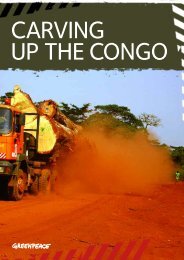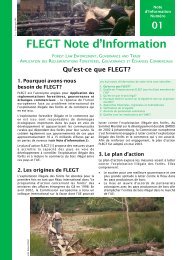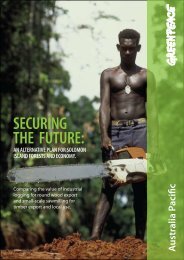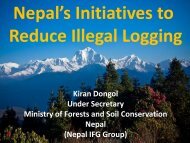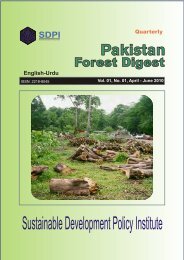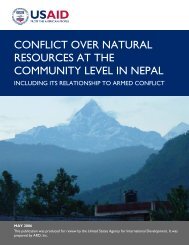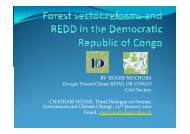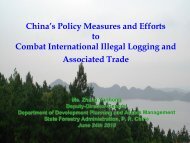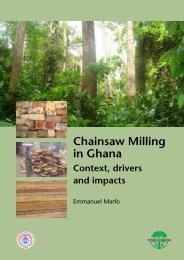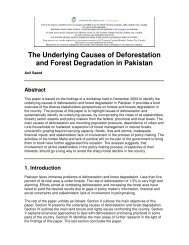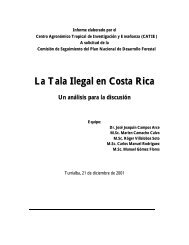download document - Rights and Resources Initiative
download document - Rights and Resources Initiative
download document - Rights and Resources Initiative
- No tags were found...
You also want an ePaper? Increase the reach of your titles
YUMPU automatically turns print PDFs into web optimized ePapers that Google loves.
Historical <strong>and</strong> contemporary l<strong>and</strong> laws <strong>and</strong> their impact on indigenous peoples’ l<strong>and</strong> rights in Ug<strong>and</strong>a:The case of the BatwaIIntroductionOver the past century, indigenouspeople in the Great Lakes Regionof Central <strong>and</strong> East Africa havebecome economically, politically<strong>and</strong> socially marginalised. This isdue to the interplay of severalfactors including developmentactivity, political instability,population growth, deforestation,<strong>and</strong> ethnic discrimination <strong>and</strong>stigmatisation. Prominent amongsuch indigenous groups are theBatwa of south-west Ug<strong>and</strong>a, whosuffer abject poverty, exclusion,<strong>and</strong> denigration from bothagriculturalists <strong>and</strong> pastoralists. 1Currently, the majority of the Batwa live in or near the forest, which is a source of theirlivelihood <strong>and</strong> culture. 2 Many Batwa who have been evicted from the forest derive theirsustenance from casual labouring <strong>and</strong> begging. 3 The Batwa face the eight majorimpoverishment risks within the displacement process: l<strong>and</strong>lessness; joblessness – since theforest was the main source of livelihood; 4 homelessness; marginalisation; 5 increasedmortality; 6 food insecurity; loss of access to common property resources; social disarticulationarising from the forced change of lifestyle. 7The plight of the Batwa is attributed to the blatant deprivation of customary l<strong>and</strong> rights. Longbefore today’s state of Ug<strong>and</strong>a was formed, their rights to l<strong>and</strong> were collective, founded on aclan rather than an individual basis. 8 They lived in harmony with their surrounding natural1 Woodburn, (1997), p 345.2 This is in Kisoro District around Bwindi <strong>and</strong> Mgahinga National Park (The Ug<strong>and</strong>a Bureau of Statistics reportof 1991 states a population of 935 Batwa in this area). See also Kabananukye <strong>and</strong> Wily, (1996), p 19.3 Penninah <strong>and</strong> Kenrick, (2002), p 1.4 Cernea <strong>and</strong> Schmidt (2003) note that the difficulty of introducing alternative income-generating activities tomitigate income losses arising from conservation underlines the fact that monetary compensation is not anoption for hunter–gatherers.5 Additionally, the Batwa suffer injustice <strong>and</strong> discrimination in local council courts. There is bias against themin the adjudication of their complaints, especially if the adversary is from the dominant community.Ultimately, the Batwa are discouraged from filing complaints in the local council courts. They are furthercurtailed by the exorbitant fees charged for filing such complaints. For a further look at the marginalisationfacing the Batwa in their daily social life, see Tumushabe <strong>and</strong> Musiime (2006).6 A medical needs survey undertaken in 1999 reported the major problems faced by the Batwa to be the lack of:safe drinking water, latrines, schools, clinics, <strong>and</strong> access to government health care facilities. The childmortality rate for the Batwa was 41%, while for non-Batwa it was 17%; infant mortality rate for the Batwa was21%, for non-Batwa 5%. For a detailed study, see Rudd (2002).7 Cernea <strong>and</strong> Schmidt (2003), p 1.8 Lewis (2000), p 17.Nakayi 1January 2009




